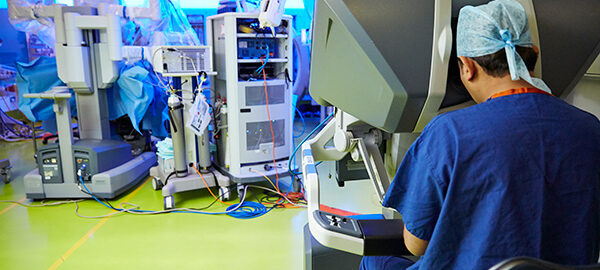Robotic prostatectomy, also called robot-assisted radical prostatectomy, is a minimally invasive surgical technique for treating prostate cancer. Professor Prokar Dasgupta—a leading robotic urology surgeon—has pioneered techniques that combine precision, safety, and faster recovery. This guide explains what patients should know about the procedure, benefits, risks, and recovery.
What is Robotic Prostatectomy?
Robotic prostatectomy involves removing the prostate gland using a surgical robot, most commonly the da Vinci system. The surgeon sits at a console, controlling robotic arms that provide:
- Magnified 3D vision for clear visualization of delicate tissues
- Tremor-free, precise instrument movements
- Access to hard-to-reach areas in the pelvis
This approach allows surgeons to remove cancer effectively while minimizing damage to surrounding nerves and tissues.
Learn more about robotic prostatectomy.
Who is a Candidate?
Robotic prostatectomy is typically recommended for men with localized prostate cancer, meaning the cancer is confined to the prostate or surrounding tissue. Suitability depends on:
- Cancer stage and grade
- Age and general health
- Baseline urinary and sexual function
- Anatomical considerations
Your surgeon will review scans, biopsies, and overall health before recommending surgery.
Key Advantages of Robotic Prostatectomy
Compared with traditional open or laparoscopic surgery, robotic prostatectomy offers several benefits:
- Smaller incisions for reduced scarring and faster healing
- Lower blood loss during surgery
- Shorter hospital stay (often 1–2 days)
- Faster recovery and return to daily life
- Precision nerve-sparing techniques to preserve urinary continence and sexual function
These benefits make robotic prostatectomy a preferred option for many patients.
Nerve-Sparing Techniques: The SAFE Method
Professor Dasgupta uses the SAFE technique (Saline-Assisted Fascial Exposure) for nerve preservation. This involves gently injecting saline to separate the prostate from surrounding nerve tissue.
Benefits of SAFE include:
- Improved visualization of delicate nerve bundles
- Reduced risk of nerve injury
- Better chances of maintaining erectile function post-surgery
Read more about the SAFE technique.
Potential Risks and Complications
While robotic prostatectomy is generally safe, risks include:
- Bleeding or infection
- Temporary or persistent urinary incontinence
- Erectile dysfunction if nerves are affected
- Injury to nearby structures such as the bladder or urethra
- Urethral or bladder neck strictures
Your surgical team will discuss your personal risk factors before the operation.
What to Expect During Recovery
Recovery times vary, but typical milestones include:
- Hospital stay: 1–2 days
- Catheter removal: about 1 week post-surgery
- Light activities: within 2–3 weeks
- Return to normal or strenuous activity: 6–8 weeks
- Urinary control improvement: over weeks to months
- Erectile function recovery: may take several months to a year if nerves are preserved
Pelvic floor exercises and rehabilitation support can improve recovery outcomes.
Cancer Control and Follow-Up
Robotic prostatectomy aims to remove all cancer while preserving quality of life. Surgeons assess surgical margins in the removed tissue. If margins are clear, cancer is likely fully removed.
Follow-up includes regular PSA testing to monitor for recurrence and ensure long-term success.
Questions to Ask Your Surgeon
Before surgery, consider asking:
- How many robotic prostatectomies have you performed?
- What are your urinary continence and erectile function outcomes?
- Will nerve-sparing be possible in my case?
- What is your rate of positive margins?
- What postoperative care and follow-up will be provided?
Conclusion
Robotic prostatectomy combines cutting-edge technology with surgical expertise to deliver precise treatment for prostate cancer. With experienced surgeons and advanced techniques like SAFE nerve-sparing, patients can achieve excellent cancer control while minimizing side effects.
For more detailed information or to schedule a consultation, visit Prokar.co.uk’s Robotic Prostatectomy page.

